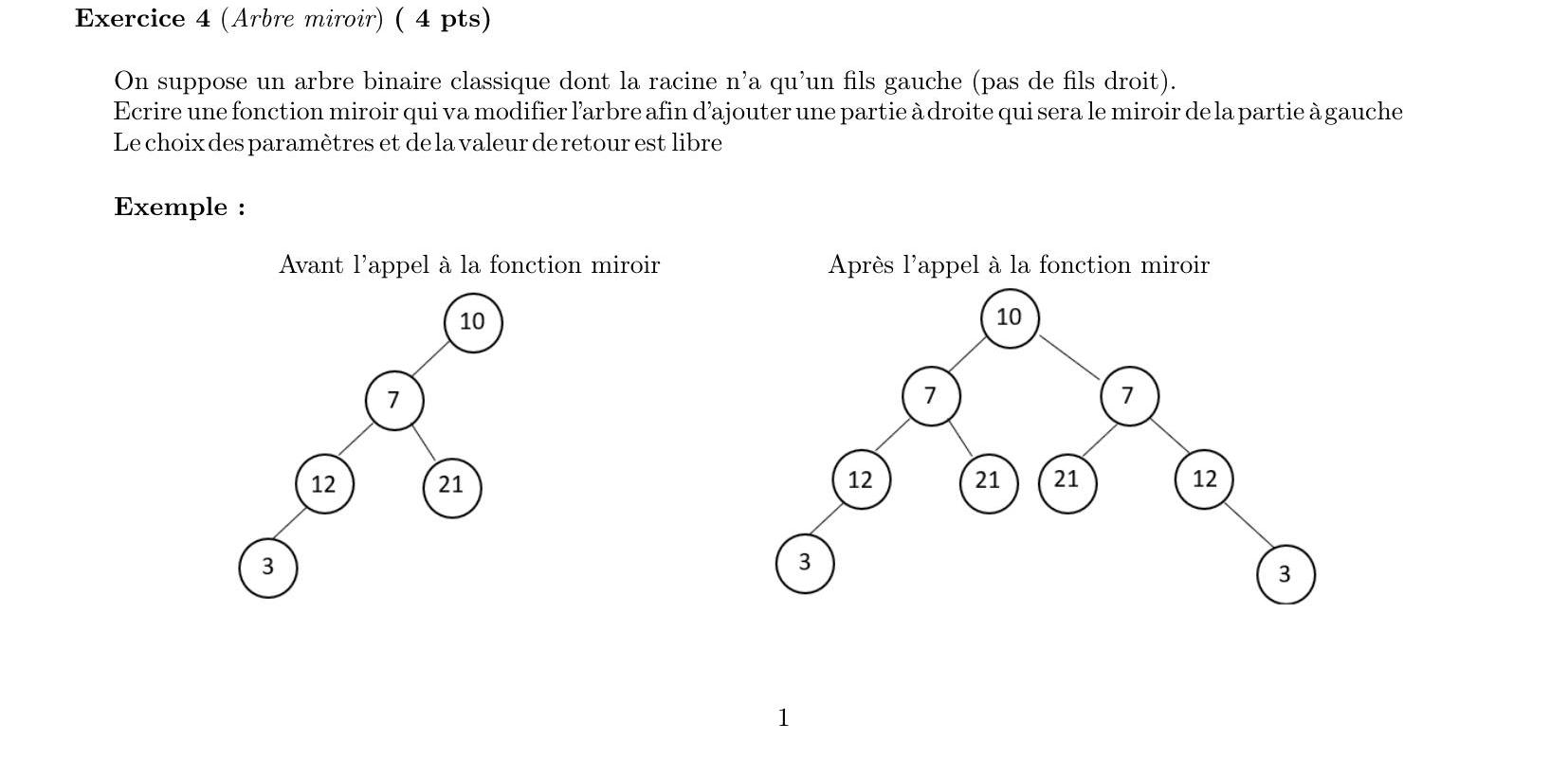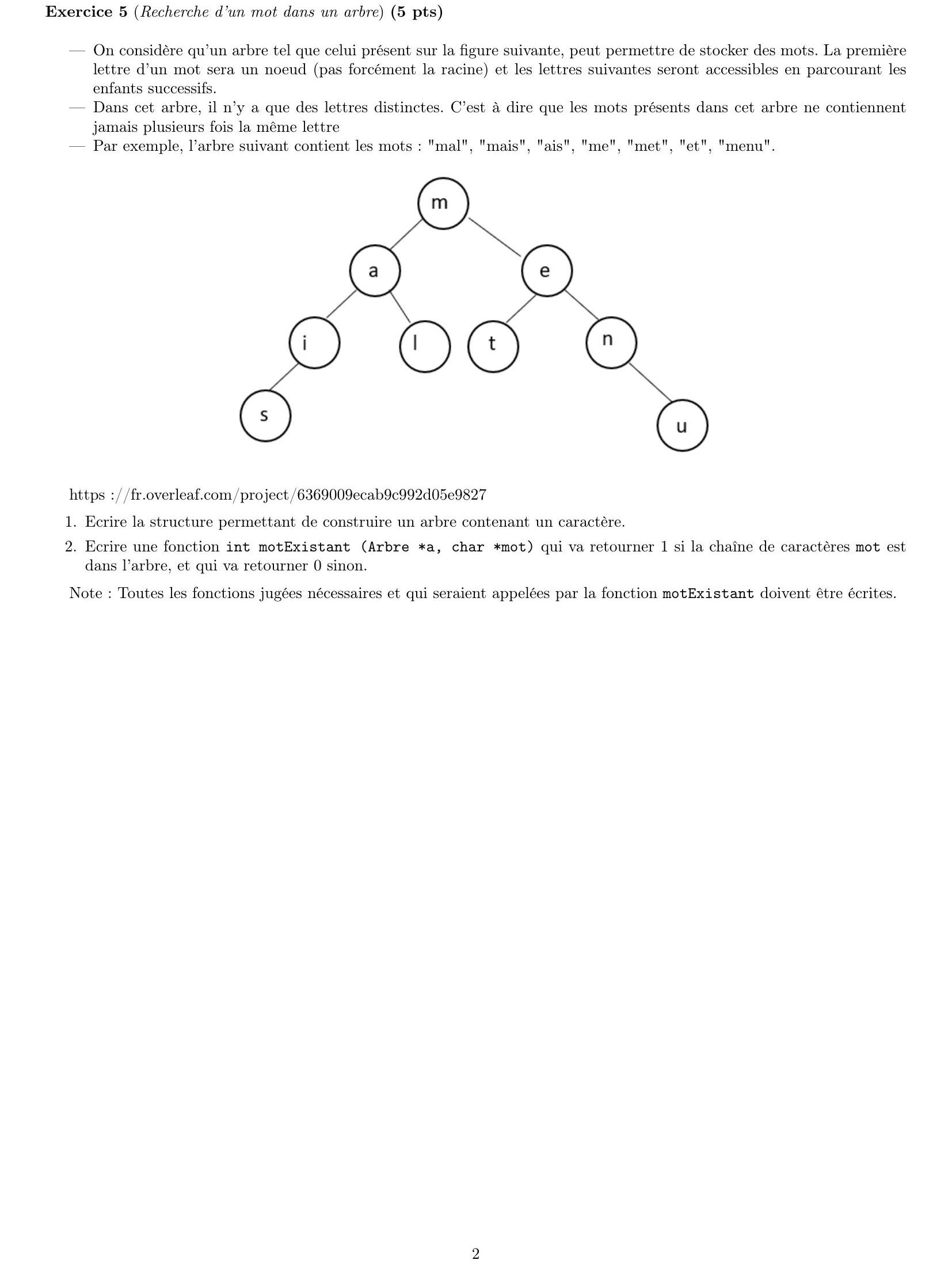Exercices : 1 2 3 4 5
Exercice 1
Télécharger l’exercice exo1.c

flowchart TD
C20(("20"))
C10(("10"))
C40(("40"))
C5(("5"))
C15(("15"))
C35(("35"))
C42(("42"))
C7(("7"))
C17(("17"))
C32(("32"))
C6(("6"))
C9(("9"))
C25(("25"))
CN1[/" "\]
CN2[/" "\]
CN3[/" "\]
CN4[/" "\]
C20 --- C10
C20 --- C40
C10 --- C5
C10 --- C15
C40 --- C35
C40 --- C42
C5 --- CN1
C5 --- C7
C15 --- CN2
C15 --- C17
C35 --- C32
C35 --- CN3
C32 --- C25
C32 --- CN4
C7 --- C6
C7 --- C9
1
| 20 10 5 7 6 9 15 17 40 35 32 25 42
|
1
| 5 6 7 9 10 15 17 20 25 32 35 40 42
|
1
| 6 9 7 5 17 15 10 25 32 35 42 40 20
|
- Fonction parcours postfix
1
2
3
4
5
6
7
8
9
10
11
12
13
14
15
16
17
18
19
| #include <stdio.h>
#include <stdlib.h>
typedef struct arbre_struct
{
int value;
struct arbre_struct* fd;
struct arbre_struct* fg;
} Arbre;
void parcoursPostfixe(Arbre* a)
{
if (a != NULL)
{
parcoursPostfixe(a->fg);
parcoursPostfixe(a->fd);
printf("%d", a->value);
}
}
|
- Ecrire la fonction
Arbre* suppMin(Arbre* pA, int* pElt)
1
2
3
4
5
6
7
8
9
10
11
12
13
14
15
|
Arbre *SuppMin(Arbre* pA , int* pElt)
{
if (pA->fg != NULL)
pA->fg = SuppMin(pA->fg, pElt);
else
{
*pElt = pA->value;
Arbre *tmp = pA;
pA = pA->fd;
free(tmp);
}
return pA;
}
|
Exercice 2
Télécharger l’exercice exo2.c

- Ecrire une fonction qui va calculer la hauteur d’un arbre
1
2
3
4
5
6
7
8
9
10
11
12
13
14
15
16
17
18
19
20
21
| #include <stdio.h>
#include <stdlib.h>
typedef struct arbre_struct
{
int value;
struct arbre_struct* fd;
struct arbre_struct* fg;
} Arbre;
int max(int a, int b){
return a > b ? a : b;
}
int hauteur(Arbre* a)
{
if (a == NULL)
return -1; // On commence a 0
return 1 + max(hauteur(a->fg), hauteur(a->fd));
}
|
la notation ``a > b ? a : b est équivalente à if (a > b) {return a;} else {return b;}
- Ecrire une fonction qui retourne 1 si l’arbre passé en paramètre est équilibré, et retourne 0 dans le cas contraire
- On peut utiliser la fonction
hauteur car les fonctions demandées dans cet exercice ne doivent pas être nécessairement optimales d’un point de vue complexité temporelle (note en bas de l’exercice)
1
2
3
4
5
6
7
8
9
10
11
12
13
14
15
| int ArbreEquilibre(Arbre* a)
{
if (a == NULL)
{
return 1;
}
int eq = hauteur(a->fd) - hauteur(a->fg);
if (eq < -1 || eq > 1)
{
return 0;
}
return ArbreEquilibre(a->fg) && ArbreEquilibre(a->fd);
}
|
Exercice 3
Télécharger l’exercice exo3.c

- Ecrire une fonction qui retourne 1 si un arbre est complet, 0 sinon.
1
2
3
4
5
6
7
8
9
10
11
12
13
14
15
| #include <stdio.h>
#include <stdlib.h>
typedef struct arbre_struct
{
int value;
struct arbre_struct* fd;
struct arbre_struct* fg;
} Arbre;
int estComplet(Arbre* a)
{
return a == NULL || ( (!(a->fd == NULL ^ a->fg == NULL)) && estComplet(a->fg) && estComplet(a->fd));
}
|
Le signe ^ est une operation booléenne correspond au $XOR$ appelé aussi “ou exclusif”, on l’utilise car si un des deux est NULL et l’autre non alors on retourne 0
Exercice 4
Télécharger l’exercice exo4.c

- Ecrire une fonction miroir qui va modifier l’arbre afin d’ajouter une partie à droite qui sera le miroir de la partie à gauche
1
2
3
4
5
6
7
8
9
10
11
12
13
14
15
16
17
18
19
20
21
22
23
24
25
26
27
28
29
30
31
32
33
34
35
36
37
38
39
40
41
42
43
44
45
46
| #include <stdio.h>
#include <stdlib.h>
typedef struct arbre_struct
{
int value;
struct arbre_struct* fd;
struct arbre_struct* fg;
} Arbre;
Arbre* creerArbre(int e)
{
Arbre* new = malloc(sizeof(Arbre));
if (new == NULL)
{ // Vérifie si l'allocation mémoire a réussi
exit(EXIT_FAILURE);
}
new->fd = NULL; // Initialisation du fils droit à NULL
new->fg = NULL; // Initialisation du fils gauche à NULL
new->value = e; // Assigne la valeur au nœud
return new;
}
void copierArbre(Arbre* source, Arbre* dest)
{
if (source != NULL)
{
if (source->fg != NULL)
dest->fd = creerArbre(source->fg->value);
if (source->fd != NULL)
dest->fg = creerArbre(source->fd->value);
copierArbre(source->fg, dest->fd);
copierArbre(source->fd, dest->fg);
}
}
Arbre* miroir(Arbre* a)
{
if ( a != NULL && a->fg != NULL && a->fd == NULL)
{
a->fd = creerArbre(a->fg->value);
miroirREC(a->fg, a->fd);
}
return a;
}
|
Exercice 5
Télécharger l’exercice exo5.c

- Ecrire la structure permettant de construire un arbre contenant un caractère.
1
2
3
4
5
6
7
8
9
10
| #include <stdio.h>
#include <stdlib.h>
typedef struct arbre_struct
{
char* value;
struct arbre_struct* fd;
struct arbre_struct* fg;
} Arbre;
|
- Ecrire une fonction int
motExistant (Arbre *a, char *mot) qui va retourner 1 si la chaîne de caractères mot est dans l’arbre, et qui va retourner 0 sinon
1
2
3
4
5
6
7
8
9
10
11
12
13
14
15
16
|
int motExistant(Arbre *a, char *mot) {
if (a == NULL || mot == NULL) {
return 0;
}
if (*mot == '\0') {
return 1;
}
if (*mot == a->value) {
return motExistant(a->fg, mot + 1) || motExistant(a->fd, mot + 1);
}
return motExistant(a->fg, mot) || motExistant(a->fd, mot);
}
|
Exercices : 1 2 3 4 5
Le contenu de cet article est la propriété exclusive de son auteur.




